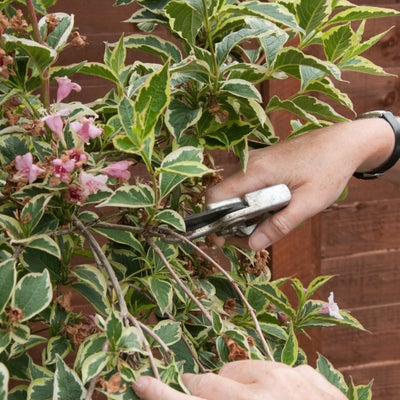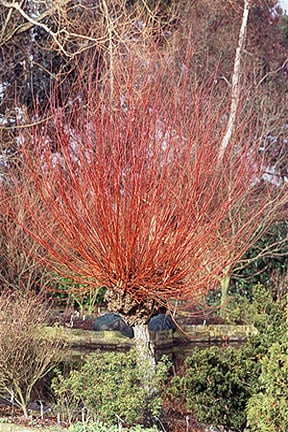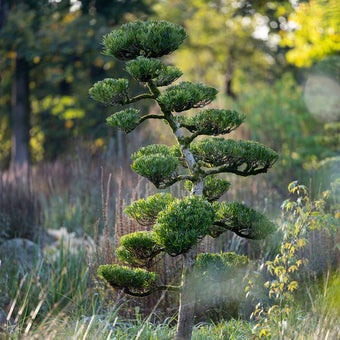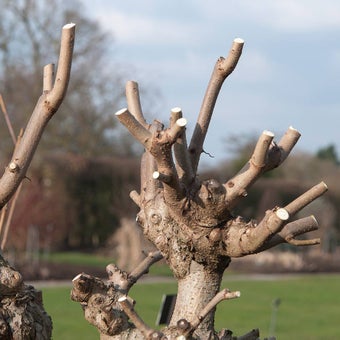
Quick facts
Suitable for - Trees, shrubs and climbers
Timing - Various
Difficulty - Moderate
Suitable for...
These pruning groups are referred to in our Plant pages. They are designed to offer gardeners a general guide on how to prune a tree, shrub or climber.
RHS Pruning Groups 1-13
Pruning group 1: Light pruning
These evergreen shrubs and trees and certain deciduous shrubs need very little pruning and are best left to their own devices in most cases. They do not send out vigorous shoots that need curbing. Remove diseased, damaged congested or crossing shoots. Shoots that are growing in unwanted directions can also be pruned out. These plants flower on previous or current year's growth.
Pruning group 2: Early-flowering shrubs
This group of shrubs flower in spring or early summer and produce flowers on strong stems developed the previous year. Examples include Philadelphus (mock orange), Forsythia and Weigela.
Pruning group 3: Shrubs that shoot from the base
These shrubs flower on the previous year's growth and send up large amounts of new growth each year from ground level or low down on the plant. They flower on one-year-old wood and older wood is almost entirely removed to make way for the new shoots. Examples include Kerria and Neillia.
Pruning group 4: Summer-flowering shrubs (Hydrangea)
Shrubs in this group flower from mid to late summer on the previous year's growth. Hydrangeas are typical of this group.
Pruning group 5: Deciduous winter- and early spring-flowering shrubs
Deciduous shrubs that flower on the previous year's growth in winter or early spring respond to hard pruning after flowering. Examples include Prunus triloba.
Pruning group 6: Summer- or autumn-flowering shrubs
For late summer or autumn-flowering shrubs that produce flowers at the ends of the current season's growth, prune in early to mid-spring when severe weather is past and growth are beginning to swell. Examples include Buddleja davidii, Caryopteris and Fuchsia.
Pruning group 7: Pruning for stems and foliage
Shrubs grown for the brilliant young stem colours are pruned very hard in late winter or early spring. All growth should be cut back hard to a stubby low framework or to ground level. Examples include dogwood (Cornus), Rubus, Cotinus, Sambucus and some Eucalyptus.
Pruning group 8: Early-flowering evergreen shrubs
Some winter, spring and early summer-flowering evergreens are best left unpruned except for removal of unsightly shoots and , unless some shaping is required. Examples include Rhododendron, Camellia, box, laurels and Viburnum tinus. Some deciduous shrubs also fall into this group.
Pruning group 9: Late-flowering evergreen shrubs
This group of evergreen shrubs bloom in summer and autumn on the previous or current year's growth. They need little pruning. Prune lightly removing unsightly shoots as required in mid to late spring. Examples include Eucryphia, Escallonia, Fatsia, Hebe and Rosmarinus.
Pruning group 10: Evergreen shrubs
This group of evergreen shrubs flower on the previous year's growth in spring or early summer, or on the current year's growth in late summer and autumn. Examples include heather (Calluna), Helianthemum, Lavandula and Thymus.
Pruning group 11: Vigorous climbers
This group of vigorous climbers flower on previous or current year's growth and don't need regular pruning. However trimming may be needed to keep them to the space available. Examples include honeysuckle (Lonicera), Parthenocissus and Trachelospermum.
Pruning group 12: Moderately vigorous climbers
This group of moderately vigorous climbers flower on the previous or current year's growth. Examples include Bougainvillea, Plumbago and Solanum crispum.
Pruning group 13: Wall-trained shrubs
This group brings together shrubs that lend themselves to wall training. They require annual pruning to keep them in check. Sideshoots need shortening and wayward shoots growing into or away from the wall removed. Examples include Camellia, Ceanothus, Chaenomeles, Garrya, Fuchsia, Magnolia grandiflora and Pyracantha.
Rose pruning groups
- Pruning group 15: Hybrid Tea roses
- Pruning group 16: Floribunda roses
- Pruning group 17: Climbing roses
- Pruning group 18: Rambler roses
- Pruning group 19: Groundcover roses
- Pruning group 20: Shrub roses – these are one flush of flower: all shrub roses including old and modern but they are mostly old fashioned shrub or species roses
- Pruning group 21: Shrub roses – these are repeat-flowering: modern shrubs including David Austin and old fashioned shrub roses
- Pruning group 22: Patio, Polyantha and Miniature roses






